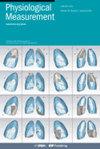用于心脏磁共振成像回溯门控的独立于患者的鲁棒 R 峰检测。
IF 2.3
4区 医学
Q3 BIOPHYSICS
引用次数: 0
摘要
目的 在心血管磁共振(MR)成像中,通过检测心电图(ECG)信号中的 R 峰来实现图像采集与心脏运动的同步(称为选通)。由于与强磁场相关的磁流体动力学效应会导致心电图信号严重失真,因此在 3T 和 7T 扫描仪上进行有效选通具有挑战性。本研究提出了一种高效的回顾性选通策略,无需事先在扫描仪外进行训练,并研究了心电图采集集中导联的最佳数量。该方法采用独立成分分析 (ICA) 技术,可有效分离与心脏活动相关的成分和与噪声相关的成分。随后,根据心率估计指标和频率内容质量指标,自动选择过程识别出最适合准确检测 R 峰的成分。主要结果该方法对不同的 B0 场强度具有鲁棒性,3T 和 7T 扫描仪采集的数据的 R 峰检测误差分别为 2.4 ± 3.1 ms 和 10.6 ± 15.4 ms。它的有效性在不同的受试者方向上都得到了验证,展示了在不同临床场景中的适用性。研究结果表明,心电图导联的数量可限制在三个,7T 场强下最多可限制在五个,而不会显著降低 R 峰检测的准确性。意义该方法无需为 R 峰检测器训练进行初步心电图采集,从而减少了总体检查时间。门控过程的设计适应性强、完全盲目且不受患者特征的影响,可在临床实践中快速广泛应用。由于只需使用有限的一组导联,因此可提高病人的舒适度。本文章由计算机程序翻译,如有差异,请以英文原文为准。
Patient-independent, MHD-robust R-peak detection for retrospective gating in cardiac MRI imaging.
OBJECTIVE
In cardiovascular magnetic resonance (MR) imaging, synchronization of image acquisition with heart motion (called gating) is performed by detecting R-peaks in electrocardiogram (ECG) signals. Effective gating is challenging with 3T and 7T scanners, due to severe distortion of ECG signals caused by magnetohydrodynamic effects associated with intense magnetic fields. This work proposes an efficient retrospective gating strategy that requires no prior training outside the scanner and investigates the optimal number of leads in the ECG acquisition set.
APPROACH
The proposed method was developed on a data set of 12-lead ECG signals acquired within 3T and 7T scanners. Independent component analysis (ICA) is employed to effectively separate components related with cardiac activity from those associated to noise. Subsequently, an automatic selection process identifies the components best suited for accurate R peak detection, based on heart rate estimation metrics and frequency content quality indexes.
MAIN RESULTS
The proposed method is robust to different B0 field strengths, as evidenced by R-peak detection errors of 2.4 ± 3.1 ms and 10.6 ± 15.4 ms for data acquired with 3T and 7T scanners, respectively. Its effectiveness was verified with various subject orientations, showcasing applicability in diverse clinical scenarios. The work reveals that ECG leads can be limited in number to three, or at most five for 7T field strengths, without significant degradation in R-peak detection accuracy.
SIGNIFICANCE
The approach requires no preliminary ECG acquisition for R-peak detector training, reducing overall examination time. The gating process is designed to be adaptable, completely blind and independent of patient characteristics, allowing wide and rapid deployment in clinical practice. The potential to employ a significantly limited set of leads enhances patient comfort.
求助全文
通过发布文献求助,成功后即可免费获取论文全文。
去求助
来源期刊

Physiological measurement
生物-工程:生物医学
CiteScore
5.50
自引率
9.40%
发文量
124
审稿时长
3 months
期刊介绍:
Physiological Measurement publishes papers about the quantitative assessment and visualization of physiological function in clinical research and practice, with an emphasis on the development of new methods of measurement and their validation.
Papers are published on topics including:
applied physiology in illness and health
electrical bioimpedance, optical and acoustic measurement techniques
advanced methods of time series and other data analysis
biomedical and clinical engineering
in-patient and ambulatory monitoring
point-of-care technologies
novel clinical measurements of cardiovascular, neurological, and musculoskeletal systems.
measurements in molecular, cellular and organ physiology and electrophysiology
physiological modeling and simulation
novel biomedical sensors, instruments, devices and systems
measurement standards and guidelines.
 求助内容:
求助内容: 应助结果提醒方式:
应助结果提醒方式:


